Steak is one of the most intimidating things to cook, and while we’ve got loads of great steak recipes, they all assume a little bit of knowledge.
We’ve put this guide together for the total beginner to learn how to grill the perfect steak from choosing the right steak to a step-by-step grilling guide packed with expert tips.
While you can follow this guide and learn to cook a great steak, truly mastering steak requires more than we can teach in one place, so we’ve included links to some of our best steak guides if you want to learn more about a topic.
How to grill the perfect steak
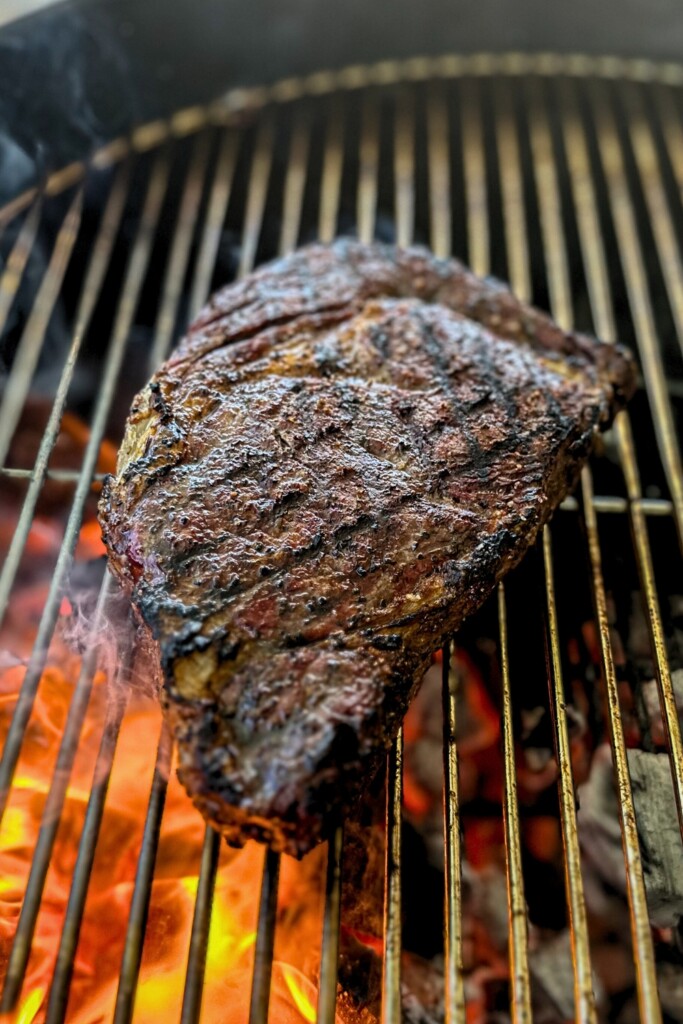
First, you need to find the perfect steak to grill. You can’t go wrong with a ribeye or NY Strip, or check out this list of our favorite steaks to grill to get you started.
We also have a guide on what to look for when buying steak. Starting with the best steak you can get your hands on is the best way to finish with a beautifully cooked steak.
What’s more important than the exact steak cut is the steak’s thickness. This is the main factor that determines the grilling technique and cooking time. We have a comprehensive guide to steak thickness, but here’s what you need to know:
- For thicker steaks (more than 1.5″ thick), use the reverse sear method.
- For thinner steaks (less than 1.5″ thick), grill hot and fast over direct heat.
We’ll explain more and give you full instructions for each below.
Grill temperature for steaks
By far the most common mistake I see beginners make when cooking steak is not allowing the grill to get hot enough.
It’s generally accepted that the best grill temperature for steaks is between 450 and 500°F. A hot grill equals a good sear.
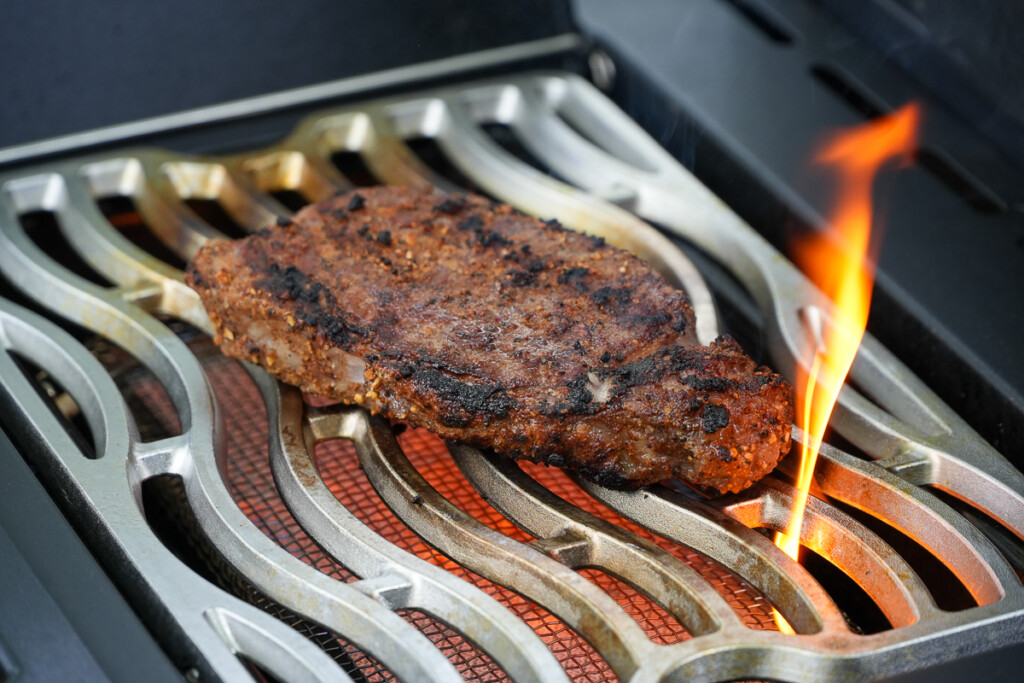
Whether you’re grilling steak on infrared, gas, or charcoal, allow plenty of time for the grates to heat up.
I’ve even cooked steak on my infrared grill that reaches 1500°F with impressive results, so I would focus on getting the grill as hot as you can.
How long should you grill steak for?
For thin steak, you want to grill it for approximately 3 to 4 minutes on each side over direct, high heat. Generally speaking, a thin steak takes 6 to 8 minutes to reach the ideal temperature for rare, and then double this to reach well done.
For thick steak, you want to cook it over indirect heat until it reaches about 15°F below your target internal temperature (according to our steak doneness guide below).
Then, you’ll place the steak over direct heat for about one minute on each side until it’s 10°F below your target temperature. The time depends on the steak’s thickness, which is why we always recommend using a meat thermometer.
How to tell when steak is done
Use an instant-read meat thermometer paired with our steak doneness guide to understand when your steak has finished cooking.
Steak doneness temperature guidelines
- Blue rare (115°F): Seared on the outside but barely cooked in the middle, a blue steak is basically still mooing. Like well done, blue steak isn’t to everyone’s taste, and the lack of cooking means the center can be chewy and taste slightly metallic.
- Rare (120°F): Just 5°F from blue is rare, seared on the outside with a bright red center that’s cool to the touch. Rare is a good level of doneness for leaner steak cuts where you don’t have to worry about rendering down the fat.
- Medium rare (130°F): The king of steak doneness levels, a good medium-rare steak has a pink center, with just a hint of red, coupled with a crisp brown crust.
- Medium (140°F): Medium steaks have no hint of red, and the meat should be pink and firm all the way through.
- Medium well (150°F): When cooked to medium well, the steak loses most of its water, drying out the meat and causing the fat to leak.
- Well done (160°F): Much like blue, most people recoil in horror at the very idea of a well-done steak. Remember, if you cook a well-done steak, you’ll have to cook on a lower heat for longer to avoid burning the outside.
Steak marinades
We don’t typically recommend marinating steak before grilling, as the suger in the marinade can burn while cooking. However, some leaner steak cuts, like flank or skirt steak, are better suited for marinades.
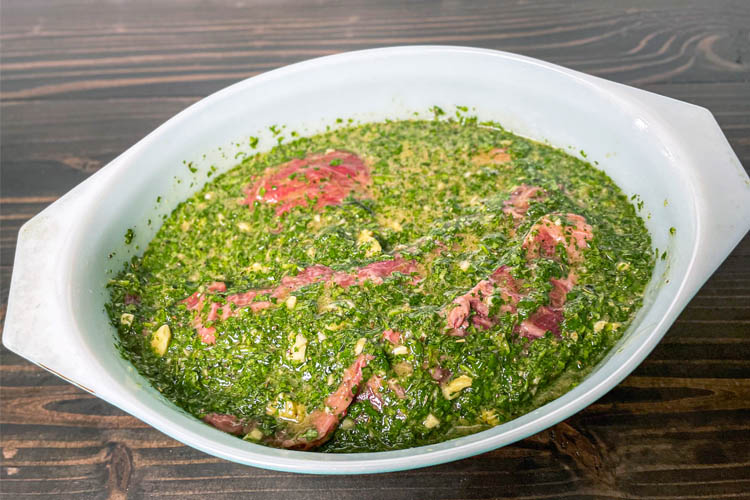
Marinated skirt and flank steak for our grilled Carne Asada recipe.
For example, we use a cilantro-lime marinade on flank steak for our grilled carne asada recipe and marinate sirloin steak for our grilled steak kabobs.
Top tips for grilling the perfect steak
Here are some tips to help you grill the perfect steak.
1. Salt ahead of time
We recommend dry brining or salting the steak the night before and leaving it uncovered in the fridge to get nice and dry. If you forget, even salting your steaks two hours in advance is better than nothing.
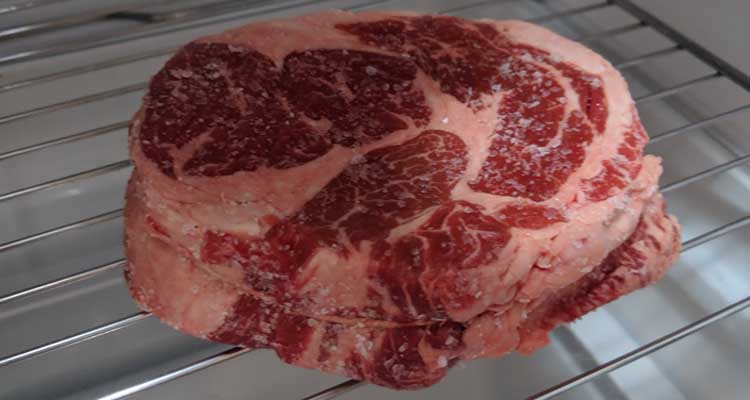
Salting steak and leaving uncovered in the fridge results in a better crust and more tender steak.
The salt draws the surface moisture out of the meat, which then dissolves the salt before the steak reabsorbs it, spreading the seasoning throughout. As you can imagine, this results in a juicier and more flavorful steak.
Try not to salt them less than 10 minutes before cooking, as the salt draws moisture to the meat’s surface, but it won’t have time to evaporate. The excess moisture can ruin your chances of getting a good sear.
2. A meat thermometer is your best friend
The humble meat thermometer is the greatest tool in your arsenal. Testing how done your meat is by touch and sight is never as accurate as using a quick-read digital thermometer like the ThermoWorks Thermapen ONE.
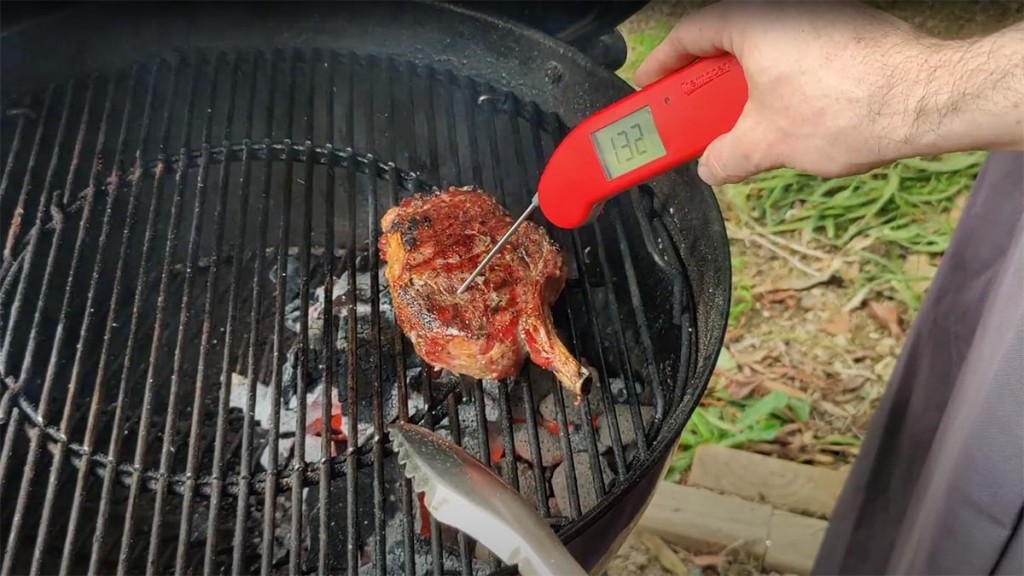
My Thermapen ONE tells me this ribeye is ready to rest.
Remember, an increase of just 10°F is the difference between rare and medium-rare, and steak continues to cook after you remove it from the grill. So, it’s a safe bet to take it off the grill just before it reaches your ideal temperature.
3. You don’t have to rest steak
Resting your steak for too long can cause it to overcook through heat carryover. The moisture in the meat can also soften your crispy crust.
My advise is to try not to stress about not resting steak either. If you need extra time to prepare your side dishes. If you need to rest it, opt for up to 10 minutes. I recommend adding a pat of butter on top and tenting the steak with foil so it doesn’t cool off too quickly.
4. Flip frequently (for the best crust)
One of the great myths of cooking steak is that, once you get it on your grill, you should flip it as little as possible. The reality is that flipping your steak regularly helps you build the crust and reduces the cooking time.
Food scientist Harold McGee’s experiments indicate that flipping your steak once every 30 seconds can cut the cooking time by as much as 30% and help to cook the meat more evenly, preventing one side from drying out.
How to get cross-hatch grill marks
A more even crust provides the best flavor. But if you want to focus on appearance, here’s how to get those signature cross-hatch grill marks.
- Get your grill as hot as possible (500 degrees).
- Place the steak on an angle to the grates.
- Rotate a quarter turn after 1 to 2 minutes.
- Grill for another 1 to 2 minutes.
- Flip and repeat the process.
Check out this video for step-by-step instructions. But for a charcoal grill, you can keep the lid on or off. I typically keep the lid off unless the steak is extra thick.
How to grill the perfect steak step-by-step
Now you have all the tips and tricks, here’s a step-by-step guide on grilling the perfect steak.
1. Plan ahead and dry brine
As mentioned, we recommend planning ahead and dry-brining your steak overnight or even up to two hours in advance. Sprinkle liberally with kosher salt and leave it uncovered in the fridge.
2. Season the steaks
I like to season my steaks and let them come to room temperature while I prep my charcoal grill (about 30 minutes to an hour). You can’t go wrong with simple kosher salt and freshly ground black pepper or salt, pepper, and garlic powder seasoning.

Some people don’t like the taste of burnt pepper and leave it until after the steak has cooked, but I love it.
If you’ve already salted your steak and left it in the fridge, you won’t need to add more salt.
3. Grill the steaks
For a gas grill, preheat it to between 450 and 500°F.
For a charcoal grill, fill 2/3 of a charcoal chimney with your preferred charcoal. I like to use hardwood lump charcoal, but briquettes work just fine.
Place a few fire starters underneath the chimney, light them, and once the charcoal has ashed over (about 20 minutes), dump the chimney in the grill using a pair of heat-resistant BBQ gloves.
Replace the grill grates, shut the lid, and fully open the vents. I then leave the grill for 5 to 10 minutes to get the grates nice and hot.
For thin steaks
Place the steak on an angle directly over high heat and close the lid. Grill it for approximately 3 to 4 minutes on each side (with the lid closed), then check the internal temperature.
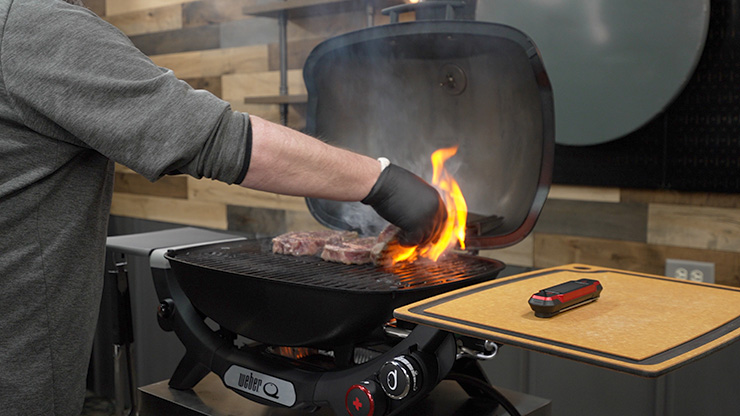
Continue, if needed, until it reaches your desired temperature.
For thick steaks (reverse sear)
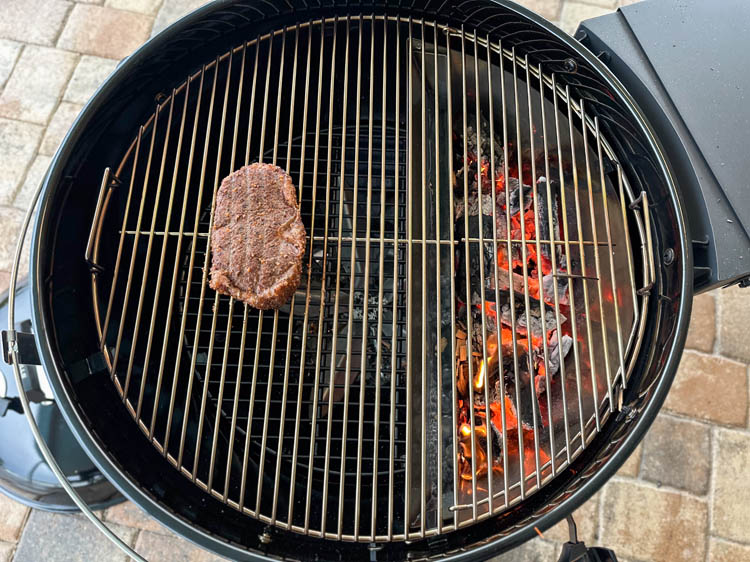
Always start thick steaks on low indirect heat before finishing with a quick sear.
- Create a two-zone system by banking your coals to one side or turning one of your gas grill burners high and the other low or off if your grill can maintain 200-250°F internal temp.
- Position the steak over indirect heat (the cool zone) so the fattier side points towards the charcoal. If you have a bone-in steak, face the bone side toward the direct heat.
- Grill the steak until it reaches about 15°F below your target internal temperature. Depending on the thickness, reaching the ideal medium-rare temperature takes approximately 10 minutes.
- Move it to the direct heat and cook for about one minute on each side (at an angle) until nicely browned. Use the above tips to achieve those cross-hatch grill marks.
- Wait until the steak is about 10°F below your target temperature, then take it off the heat as it’ll continue to cook.
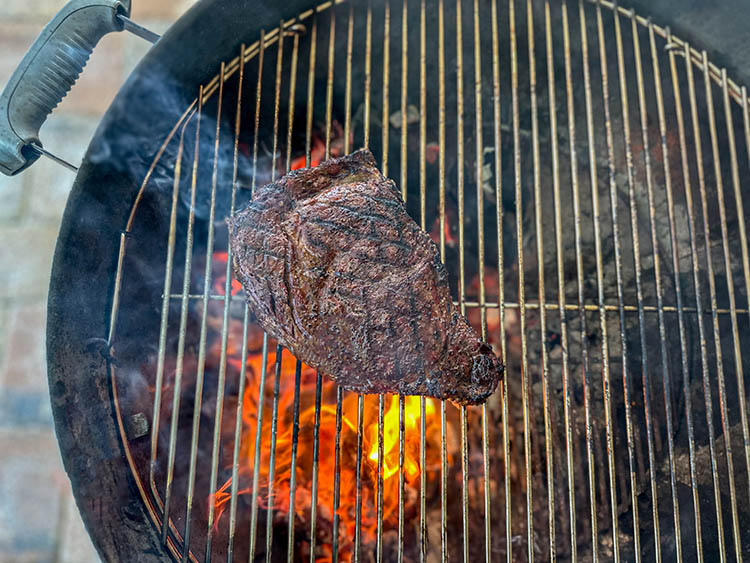
The final stage of the reverse sear is when you develop the flavorsome crust.
4. Serve
When slicing steak, cut it across the grain for maximum tenderness.
You can’t go past serving the steak with homemade compound butter to take the flavor to the next level. Both our porterhouse steak and grilled teres major recipes use a garlic herb compound butter.
Other options include an authentic chimichurri sauce or a creamy mushroom sauce. You might also like to serve your steak with one of our favorite side dishes.
Print
How to Grill the Perfect Steak
Servings 2 People
Calories 1392kcal
Author Joe Clements
- 2 Steak of your choice More than 1" thick or see note on cooking thin steaks.
- Kosher Salt
- Pepper
Garlic and herb compound butter
- 9 oz unsalted butter
- 1 tbsp garlic minced
- 1 tsp rosemary finely chopped
- 1 tsp thyme finely chopped
- kosher salt to taste
- black pepper to taste
Plan ahead and dry-brine the steak overnight or even up to two hours in advance. Sprinkle liberally with kosher salt and leave uncovered in the fridge.
Remove steak from the fridge and dry with a paper towel to remove any water. You can season with pepper or steak seasoning, but avoid adding more salt if you followed the first step.
Heat your grill up to about 200 – 250°F. On a charcoal grill, use 2/3 of a chimney of charcoal with the vents fully open until the grill hits 180°F and then close the bottom vent about 3/4. On a gas grill, turn one or two burners onto medium/low and leave one burner off to create an indirect heat zone.
Place steak on the cool side of the grill with the fattier or bone side pointed towards the hot part of the grill.
For medium rare, remove steak when it hits an internal temperature of 110 – 115°F. This can take 30-45 minutes. Place a pat of butter on the steak and wrap loosely in foil.
While your steak is resting, add more charcoal on top of the lit pieces or turn your burners up to high. Allow 10 minutes for the grill to get hot enough to sear and finish the steak.
Finish the steak with a quick sear, flipping every 45 seconds. Remove steak from the grill when it hits 127-130°F for medium rare.
Slice steak and serve.
For cooking steaks less than 1″ thick
The reverse sear method won’t work well for steaks less than 1″ thick. Grill thin steaks for approximately 3 to 4 minutes per side over direct, high heat. Generally speaking, a thin steak takes 6 to 8 minutes to reach the ideal temperature for rare, and then double this to reach well done.
Can you start the steak in the oven?
Yes, I will often start the steak in the oven at 200°F and then finish with a sear over charcoal or gas. You miss out on the opportunity to add some flavor during the first stage of the cook, but you don’t have to worry about switching your grill from low and slow to hot for the final sear.
If you like your steak more well done
For medium rare, we recommend removing the steak when it hits an internal temperature of 110 – 115°F. This is lower than most recipes, but we think it gives you more time to sear the outside of the steak without overcooking the middle. If you prefer your steak medium, I would remove it at around 125°F
Beware of carry-over cooking
Your steak will keep cooking when you remove it from the heat, so allow for an extra 5-10°F while you are serving. Calories: 1392kcal | Carbohydrates: 2g | Protein: 47g | Fat: 135g | Saturated Fat: 80g | Polyunsaturated Fat: 5g | Monounsaturated Fat: 42g | Trans Fat: 4g | Cholesterol: 412mg | Sodium: 132mg | Potassium: 659mg | Fiber: 0.2g | Sugar: 0.1g | Vitamin A: 3271IU | Vitamin C: 3mg | Calcium: 58mg | Iron: 4mg
 Backyard GrillingWeekend WarriorsAdvice from DadBeard GroomingTV Shows for Guys4x4 Off-Road CarsMens FashionSports NewsAncient Archeology World NewsPrivacy PolicyTerms And Conditions
Backyard GrillingWeekend WarriorsAdvice from DadBeard GroomingTV Shows for Guys4x4 Off-Road CarsMens FashionSports NewsAncient Archeology World NewsPrivacy PolicyTerms And Conditions
